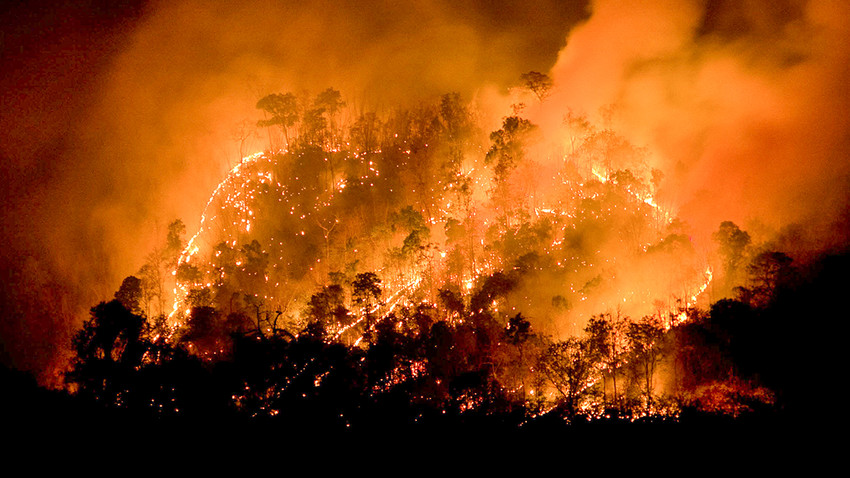
What a Blazing Summer!
Leaving the Olympiad games and the COVID-19 Delta variant out of the picture for a moment, this summer’s unfolding story about wildfires is enough to give any thinking person pause. Even so, yesterday’s headline was jolting, “Smoke from wildfires reaches the North Pole for the first time in recorded history.” The report opens: “Wildfire smoke has made it to the North Pole for the first time in recorded history, NASA said, as multiple blazes continued to rage across Russia on Tuesday. One of the country's coldest regions has been especially hard hit, with smoke so bad that it blacked out the sun, the Guardian newspaper reported” (www.cbsnews.com/news/smoke-russia-wildfires-reaches-north-pole/).
Turns out it’s Siberia that’s burning. “The Sakha Republic in Siberia is one of the coldest areas in the world and sits on top of permafrost. This year it has seen record high temperatures and drought, and vast swaths of its forests have burned.” One scientist described this unprecedented blaze: “‘There have always been large fires in Siberia. It is a landscape evolved to burn,’ Jessica McCarty, an earth scientist at Miami University in Ohio, told NASA's Earth Observatory. 'What is different because of climate change is that fires are burning larger areas, affecting places farther to the north, and consuming fuels that would have been more fire resistant in the past’” (ibid).
Not even the pristine icy wilderness of the Arctic's the North Pole is immune.
South Lake Tahoe is a sunny world away from that hinterland. But as we vacationed there with my siblings and their spouses in July, on an afternoon hike we noticed an intriguing formation of clouds peeking up above the southern mountain ridge. Someone commented on it. A few minutes later that cumulus cloud had grown. And eventually, we spotted orange hues to its pure white billows. As we learned later, it was another wildfire in that state on fire, this one the Tamarack fire. To the north of Lake Tahoe (beyond our view) still burns the Dixie fire, the largest wildfire in California history.
So what’s up? Siberia, California, the West Coast states—just another aberration of Mother Nature that we’ll get over as soon as the news cycle finds another tantalizing story to cover?
TIME magazine observes: “Flames light up hillsides in British Columbia. Smoke swells over highways into Athens. A swimming pool in California is surrounded by charred rubble. Thick forests in Siberia lie shriveled and brown. Countries across the northern hemisphere this summer are experiencing the worst wildfires in years of recorded history, with large swaths of land and entire towns in Europe, North America and Russia consumed by flames since the start of July. Though many of these countries are used to summer fire seasons, climate change is making the hot, dry conditions that allow fires to catch and spread more common and more intense” (time.com/6087748/wildfires-around-the-world-photos/).
Are these wildfires eschatological harbingers? I can’t imagine they wouldn’t be. But then we’ve always believed Jesus is coming soon. “More and more, as the days go by, it is becoming apparent that God’s judgments are in the world. In fire and flood and earthquake He is warning the inhabitants of this earth of His near approach” (9T 97). Truth is, we are the red-handed culprits whose wanton consumption and waste of natural resources have triggered the imbalances exacerbating radical weather swings. Our greedy depletion of earth’s choicest gifts has a left a planet with the pox of judgment upon it—a judgment we ourselves have rendered.
“The time has come . . . for destroying those who destroy the earth” is the Apocalypse’s dark warning (Revelation 11:18).
So with that cheerful note, on the eve of a new year here at Andrews University, with more of COVID than fires on our minds, what shall we pray for as the campus church? What a perfect confluence for us to claim the ancient promise: “Ask the LORD for rain in the time of the latter rain. The LORD will make flashing clouds [thunderstorms—NIV]; He will give them showers of rain [drenching rain—Robert Alter]” (Zechariah 10:1 NKJV). “Drenching rain” for the out-of-control wildfires across the northern hemisphere—why not ask for it? But in the same breath, we must plead for the “thunderstorms” and “drenching rain” of the mighty Holy Spirit, whose outpouring has a been promised for “the last days” (Acts 2:17). It is time, it is high time, for God’s friends on earth to cry out for His rain-soaked intervention. Let those showers inundate this campus, this congregation, this global remnant community—and a people very much like Jesus will be raised up for such a time as this. So pray for the fire, pray for the rain, plead for the mighty Spirit of Jesus. It is time.